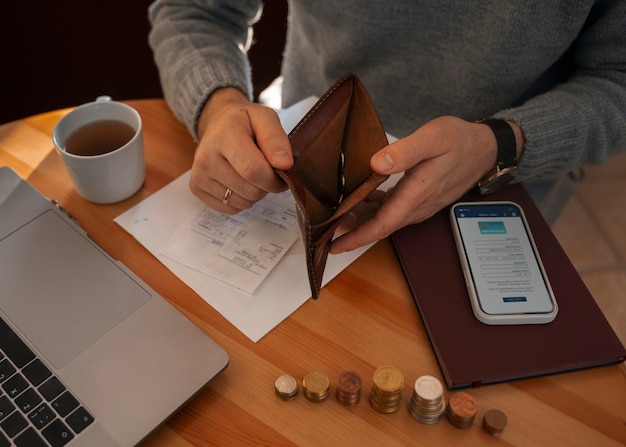Have you ever been owing more on a loan than what the purchased item is worth? That’s what’s known as an upside-down loan, and it’s a position you’d likely prefer to avoid. It can happen with cars, homes, or any big-ticket item you’ve financed, leaving you in a financial pickle.
Understanding how you’ve landed in this upside-down situation is critical to navigating out of it. It’s not just about market values dipping; it’s often a mix of high interest rates, extended loan terms, and the speed at which your asset depreciates. Let’s dive into the mechanics of upside-down loans and how they affect your financial health.
What is an Upside-Down Loan?
An upside-down loan occurs when you owe more on a loan than the asset’s current value. It’s a scenario no borrower wants to find themselves in, but it’s surprisingly common, especially with items that depreciate quickly after purchase. An upside-down loan is also referred to as being “underwater” or having “negative equity.”
When the balance of your loan overshadows the asset’s market value, you’re tied to paying off more than what you could recoup by selling the item. This situation often happens with automobiles, as a new car can lose a significant portion of its value when driven off the lot.
Consider this: you purchase a new vehicle for $30,000 with a loan. You still owe $25,000 a year after making payments, yet the car’s value has dropped to $20,000. You’re now upside-down on your car loan. Similarly, homeowners can find themselves upside-down on their mortgages if property values plunge after they buy a house.
What propels a borrower into an upside-down loan? There are several contributors, such as:
- Depreciation
- High-interest rates
- Small down payments
- Long-term financing options
Awareness of these factors is vital as they directly impact your financial stability and options for managing debts efficiently.

Causes of Upside-Down Loans
Understanding the common causes of upside-down loans is crucial. You’ll want to pinpoint these to avoid falling into the same trap, which may hinder your financial flexibility. One primary factor contributing to an upside-down loan is depreciation. When you drive a new car off the lot, it loses value rapidly. Similarly, housing markets can experience downturns, which deflate home values below purchase prices.
High-interest rates also play a vital role. They can dramatically increase the cost of a loan, especially if you’ve opted for a loan with variable rates. Consequently, when a significant portion of your payments goes toward interest instead of the principal, you’re less likely to keep pace with depreciation.
Another noteworthy cause is a small down payment. Putting less money upfront means borrowing more, and if the item depreciates faster than you’re paying off the loan, you’ll quickly find yourself underwater. Combine that with long-term financing options, and the situation escalates since smaller payments over a more extended period also mean you’re chipping away at the principle at a slower rate.
It’s crucial to be vigilant about these factors when making large purchases. Always consider how your financing choices might affect the loan-to-value ratio over time. Keeping a close eye on market trends and choosing more conservative financing options could help you avoid an upside-down loan.
The Role of Interest Rates in Upside-Down Loans
Interest rates play a crucial role in the structure of your loan and, ultimately, in determining whether you’ll end up with an upside-down loan. When you agree to a loan with a high-interest rate, a significant part of your monthly payment goes toward interest rather than principal. This means that the principal – the amount borrowed – diminishes more slowly.
Remember, the value of items like cars and homes often depreciates faster than you can pay off the loan. With high-interest rates:
- More money is allocated to interest,
- Less money is applied to the principal,
- Depreciation outpaces your payments, and
- The risk of becoming upside-down increases.
It’s not just the interest rate itself; it’s also the type of interest rate. Adjustable-rate loans might start low but can climb over time, catching you off guard and boosting your risk of an upside-down loan if your payments don’t keep up with the rate increases. Fixed interest rates, however, offer predictable payments that can help manage the loan-to-value ratio more effectively.
Even slight differences in interest rates can significantly impact your loan’s balance over time. Every percentage point counts, and an interest rate that’s even slightly lower can save you a considerable amount in the long run. They may prevent you from falling into an upside-down loan situation. When considering financing options, always consider the interest rate and how it will interact with the asset’s depreciation timeline.

The Impact of Loan Terms on Upside-Down Loans
When navigating through financing options, the length of your loan term can significantly affect whether you’ll find yourself with an upside-down loan. Shorter loan terms typically mean higher monthly payments. Still, they also allow you to pay off the principal faster, reducing the risk of your loan balance exceeding the value of your financed item.
Longer loan terms, conversely, lower the monthly payment, but they extend the duration over which interest accumulates. This can slow down the pace at which you gain equity. It’s crucial to strike a balance that aligns with your financial comfort zone while keeping equity growth in mind.
Another aspect often overlooked is the speed at which depreciation occurs versus the rate you pay down the loan. Vehicles, for example, lose value quickly; if your loan term is too long, you could pay down the loan slower than the depreciation rate.
Your choices have long-term consequences, and it’s important to anticipate potential changes in your financial situation. Opting for more manageable payments with a longer term might seem attractive, but it could lead to a scenario where you owe more than the asset is worth if you’re not careful.
Always review the terms and calculate how much you’ll be paying over the life of the loan. Aim to find a term that’s not too long to avoid excessive interest charges and not so short that monthly payments become a burden. Consider making extra payments when possible to reduce the principal balance more quickly.
Asset Depreciation and Upside-Down Loans
When you finance a purchase, you often focus on the immediate benefits, but it’s also essential to consider the long-term implications. Asset depreciation plays a critical role in understanding upside-down loans. Depreciation is the process by which an asset loses value over time. For cars, depreciation is steep; a new vehicle can lose up to 20-30% of its value in the first year alone.
- New Cars: Depreciate rapidly in the beginning
- Used Cars: Depreciate at a slower rate
Given the rapid rate of depreciation for new vehicles, you’ll find that even with regular payments, the value of your car may drop faster than you’re paying off the loan. This becomes especially problematic if you’re in the market to sell or trade-in your vehicle. You might realize that the sale won’t cover the remaining balance on your loan, trapping you in an upside-down loan scenario.
When selecting an asset to finance, consider the depreciation rate alongside the loan’s interest rate and term. Because used cars depreciate slower, they are often a more intelligent choice for avoiding upside-down loans. However, even with used cars, selecting a loan with a term short enough is imperative to keep pace with the asset’s declining value.
By understanding the depreciation curve, you can strategically plan your finance options to align with the asset’s life cycle, reducing the risk of ending up with an upside-down loan. Keep an eye on market trends as well since they can influence the rate of depreciation and, consequently, the equity you hold in your financed asset.
Navigating Out of an Upside-Down Loan
Act swiftly can be crucial when you’re trapped in an upside-down loan. Begin by assessing the current value of the asset in question—this will be your baseline for any decisions. You can use online appraisal tools or seek professional evaluations for a more accurate figure.
After determining the value deficit, consider the following strategies to correct the situation:
- Make Larger Payments: Increase your monthly payments to reduce the principal balance faster than the amortization schedule.
- Refinance the Loan: If interest rates have dropped or your credit has improved, refinancing could offer more favourable terms, helping you quickly catch up to the depreciation.
- Sell the Asset: Though it might not cover the entire loan balance, selling the asset allows you to pay down a significant portion of the debt.
- Use Savings: If available, apply any savings to pay the loan balance; ensure it doesn’t compromise your financial stability.
Be strategic about which method to adopt, as each has potential benefits and trade-offs.
Next, explore additional resources such as GAP insurance or loan modification programs. GAP insurance can cover the difference between what you owe and the asset’s value in case of a total loss, whereas loan modification programs could adjust your loan terms to help you manage the debt better. Always review the terms carefully to ensure they align with your financial goals.
Regularly revisiting your debt situation and staying informed about your options can gradually steer you away from an upside-down loan. It’s an ongoing process, but you can navigate your finances back to solid ground with patience and discipline. Keep up-to-date with the latest financial advice, and consult a financial advisor for personalized guidance tailored to your unique circumstances.

Conclusion
Navigating out of an upside-down loan can feel daunting, but with the right strategy, you’ll find light at the end of the tunnel. Stay proactive about managing your debt and keep informed about your options. You’ve got the tools to turn the situation around—larger payments, refinancing, or even selling the asset when necessary. Remember, resources like GAP insurance and loan modification programs are there to help. Regularly review your finances, and you’ll set yourself on a path to financial stability. Stay confident; you’re not stuck with an upside-down loan forever.
Frequently Asked Questions
What is an upside-down loan?
An upside-down loan occurs when you owe more on the loan than the current value of the asset it was used to purchase.
How can I find out the current value of my asset?
To assess the current value of an asset, you can use trusted online valuation tools, get a professional appraisal, or compare similar items being sold.
What are the benefits of making larger payments on an upside-down loan?
Making larger payments can reduce the principal balance faster, helping to realign the loan amount with the asset’s current value.
Is refinancing a good strategy for an upside-down loan?
Refinancing might be a good strategy if you can secure a lower interest rate or a longer payment term, which could lower your monthly payments and provide relief.
Should I sell the asset if my loan is upside-down?
Selling the asset can be a viable option if you can cover the loan shortfall or if it helps prevent further financial strain.
How can using savings help with an upside-down loan?
Using savings to pay down the loan balance can reduce the amount you owe, bringing it closer to or below the asset’s current value.
What is GAP insurance, and how can it help?
GAP insurance covers the difference between an insurance payout and the remaining loan balance if the asset is totalled or stolen, protecting you from paying out of pocket for a lost or depreciated asset.
Are loan modification programs beneficial for upside-down loans?
Loan modification programs may offer benefits such as lower interest rates or extended loan terms, which can reduce monthly payments and improve your debt situation.


